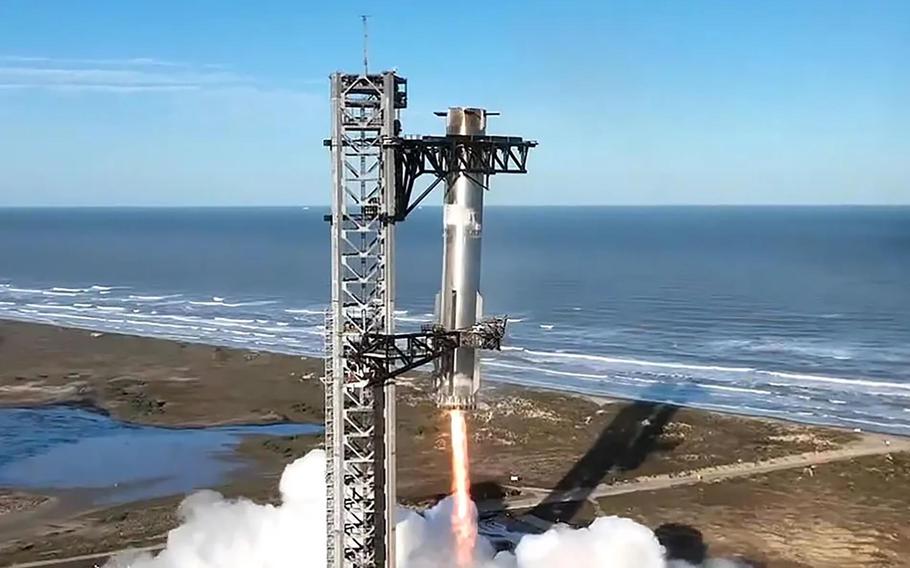
A SpaceX Starship Super Heavy booster makes a successful return, caught at the launch tower in Boca Chica, Texas, on Thursday, Jan. 16, 2025. (SpaceX/TNS) ()
SpaceX sent up its first test flight of the year for its Starship and Super Heavy rocket from Texas, catching the booster for just the second time back at the launch site, but suffering a loss of the upper stage.
The seventh test flight overall for the 396-foot-tall combined rocket lifted off from SpaceX’s Starbase facility in Boca Chica, Texas, at 5:37 p.m. Eastern time.
“We do believe that we have lost the ship during its ascent phase,” said SpaceX commentator Kate Tice. “It successfully separated from the Super Heavy booster, but during that ascent phase, a couple of the engines dropped out, and then shortly thereafter we lost communication with the vehicle.”
The booster recovery at least was a repeat of the spectacle SpaceX achieved on its fifth test flight last year, nailing a recovery back at the launch tower using what the company calls the tower’s “chopsticks,” which swivel in to grab hold of the booster as it makes a powered, hovering descent.
The sixth test flight last November skipped the attempt because of some sensor damage done to the tower on liftoff, but SpaceX was able to make the most controlled landing yet of its Starship upper stage over the ocean.
For Thursday’s successful recapture, the launch tower had been outfitted with radar sensors, aiming to increase accuracy measuring distance between the chopsticks and the booster as it came in for the catch. Of note, one of the 33 engines on this flight flew previously on the fifth test flight, marking the first reuse of a Raptor engine. The tower sensors also featured more protection to avoid the damage seen on the sixth test flight, giving SpaceX a better chance at nailing the capture.
If safety parameters had not been met as the booster made its way back to the pad, the flight director would have ordered it to veer off for a splashdown in the Gulf of Mexico as it did on the sixth test flight.
For the lost upper stage, though, SpaceX will have to revisit its plans on a future flight. This lost vehicle was what SpaceX called a new generation upper-stage ship, and the mission was going to attempt its first payload deployment test.
“We are obviously bummed out about the ship. It looked like we lost contact with it a little under eight and a half minutes into flight. That’s roughly when you start to get to that main engine cutoff,” said fellow commentator Dan Huot.
Designers continue to experiment with its shape, such as moving the location and size of its forward flaps, while also trying out various heat shield solutions.
SpaceX was not yet ready to try a recovery landing of the upper stage, though, and it was going to try a splashdown again a little more than an hour after launch.
On board were 10 Starlink-size simulators that were to be deployed and follow Starship’s trajectory so they also would have splashed down in the ocean. The flight plan also called once again for a relighting of a single one of the upper stage’s six Raptor engines.
Plans for this year’s spate of test flights do include sticking the upper stage landing as well as performing a propellant transfer in space, something that will be needed when Starship is used for NASA’s Artemis moon missions.
The Super Heavy booster powered by 33 Raptor engines produces up to 16.7 million pounds of thrust at liftoff, making it the most powerful rocket in history to reach space, although so far all the test flights have been suborbital, with the upper Starship stage only traveling partway around the Earth with target splashdown landings in the Indian Ocean near Australia.
The seventh flight had been aiming to take the same path, but ultimately fell short.
“We obviously need to go through all the data. It’s going to take some time in the next hours, days, we’re going to figure out exactly what happened, come back, fly the next one, getting farther,” Huot said. “Reminder, it’s a test. It’s a flight test. It’s an experimental vehicle. So we’ll figure out what ended our day today and make sure it doesn’t end our day tomorrow.”
All test flights to date have taken place from Texas, but SpaceX has two launch sites planned from the Space Coast in Florida. It’s already building out a tower at Kennedy Space Center’s Launch Complex 39-A, adjacent to where it launches Falcon 9 and Falcon Heavy missions. It’s also aiming to build out a tower at neighboring Cape Canaveral Space Force Station, taking over Space Launch Complex 37, which had been the home for United Launch Alliance Delta IV Heavy’s final launches.
Environmental impact studies for both sites were started in 2024, but expected to be complete this year.
SpaceX’s plans are to build up infrastructure in Florida and potentially other launch sites to get to hundreds and eventually thousands of Starship launches a year, part of Musk’s goal of creating a colony on Mars.
NASA, though, is awaiting a working version of Starship to act as the human landing system for its Artemis III mission, which is aiming to fly as early as mid-2027, and would mark the first time humans, including the first woman, will have set foot on the moon since the end of the Apollo program in 1972.
NASA requires SpaceX to perform a successful uncrewed flight of Starship landing on the moon ahead of that mission as well.
_____
©2025 Orlando Sentinel. Visit at orlandosentinel.com. Distributed by Tribune Content Agency, LLC.